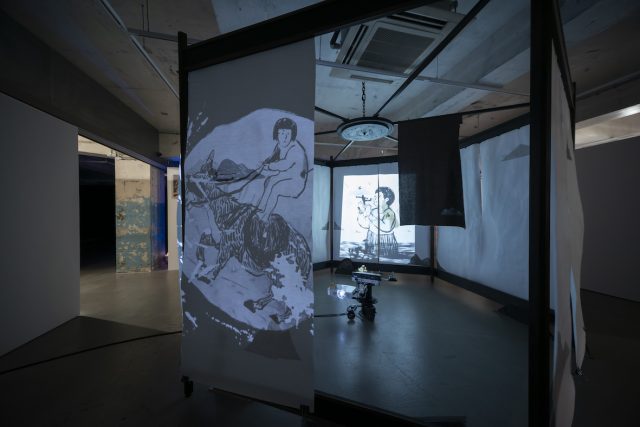Titled Garden of Six Seasons after the Edwardian-style garden built by a Nepalese king a hundred years ago in Kathmandu, a new exhibition at two galleries: Soho House and Para Site, explores the literal and metaphoric importance of gardens across different cultures.
The large-scale group show brings together multiple generations of international artists with work by Ashmina Ranjit, one of the most important feminist artists in South Asia, Swiss healer Emma Kunz, major figure of American conceptualism Charles Gaines, and filmmaker Andrew Thomas Huang, plus many more. They dissect how gardens have played a role in mapping visions of the world.
“It’s a beautiful show, one that creates a strong atmosphere,” says curator Cosmin Costinas. “In some places you might see things that look like gardens but otherwise it is metaphoric, standing for everything that gardens have represented historically in culture.”
Miasma, Plants, Export Paintings by Pan Lu and Wang Bo, 2017
As artificial environments that exploit nature, gardens have often existed in places that nature shouldn’t. At Soho House, a video by Dominique Gonzalez-Foerster shows an overgrown colonial-era garden in Rio de Janeiro, designed by French urbanist Alfred Agach. It demonstrates the strangeness of aesthetic formality and symmetry imposed on the Brazilian landscape, where the tropical climate allows vegetation to flourish and become unruly. It’s also, therefore, a comment on the limitations of colonial control.
Some artists physically incorporate nature into the exhibition space like Guatemalan-artist Naufus Ramirez-Figueroa, whose work was commissioned by Para Site for the exhibit. His sculptured plant-pots shaped like people in various yoga poses serve as a host to houseplants that have become trendy in rich urban communities around the world.
Others use gardens symbolically, as has been done throughout history, to imagine the cosmos or demonstrate how the body functions — tending to a garden is similar to healing the body or keeping a cosmic balance. Local artist Wing Po So who was born into a family of Chinese traditional medicine practitioners uses her knowledge of herbs, flows of energy, astrological science and traditional philosophy to explore the physical and philosophical world, creating sculptures that draw on elements found in nature.
In many cultures the term for paradise comes from the word garden, with religious art often drawing on them for inspiration. For contemporary Balinese artist Citra Sasmita, who tries to unravel the myths and misconceptions of religious art and culture, she incorporates women into mythological gardens to help her to reimagine a post-patriarchal future. At the same time, she reclaims the colonial Dutch narrative that depicted Bali as an exotic “last paradise,” the politics of Baliseering became the foundation for tourism and art history in Bali.
The work of the late Nigerian artist J.D.’Okhai Ojeikere is more figurative — his Hairstyle series of black and white portraits from 1968-2013, looks at the specific experimental and traditional hairstyles found across Nigeria deployed for social occasions, and worn as symbols of status or family genealogy. His subjects tend to their hair with the same care people would care for a garden — shaping something that is natural, in an often unnatural way.
Kiss of the Rabbit God by Andrew Thomas Huang, 2019
There’s no right way to start the exhibition but visitors are encouraged to experience both venues. On Para Site’s top floor, you will find artists who have worked in different traditions, gongbi and xieyi, braidings of hair and pandanus, with the core of the exhibition being centred around medical thought — its different cultural histories and understandings of diseases, what is to be healed, what can be left untouched, and when to let go. There’s explorations of gendered histories, sexuality, pleasure and pain. While, at Soho House a focus on the repercussions of colonisation and cultural exchange is at the heart of almost every piece. Visitors will be, “stepping into two very different spaces, with different stories being told,” says Costinas.
‘Garden of Six Seasons’ is on view at Para Site and Soho House Hong Kong from 16 May to 30 August.
Editor
Emma RussellCredit
Lead image: J.D.’Okhai Ojeikere, Untitled, 1975




